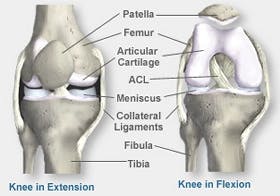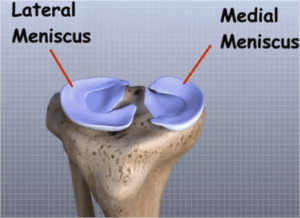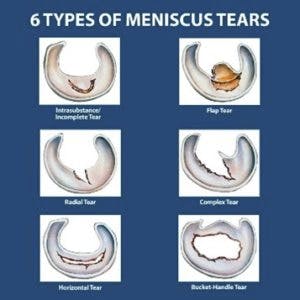The Meniscus
Anatomy
The knee is a hinged joint made up of your thigh bone (femur) and your shin bone (tibia). The ends of the bones are covered with a smooth surface called articular cartilage (Fig 1). When this surface cartilage wears out it is called arthritis.
 Fig 1
Fig 1
The meniscus is a C shaped piece of cartilage that acts as a “shock absorber” in the knee and protects the articular cartilage on the surfaces of these bones. There are two menisci in each knee. The one on the inside is known as the medial meniscus and one on the outside is the lateral meniscus (Fig 2). In addition to protecting the joint surfaces, the meniscus also provides stability within the knee joint.
 Fig 2
Fig 2
Mechanisms of Injury
Sometimes the meniscus can be damaged or torn. This tear can be thought of as a “hang nail” within the knee joint. There are two major classifications of meniscus tears. The first type, categorized as degenerative tears (Fig 3), is a common finding as the articular cartilage breaks down over time and can damage the adjacent meniscus. The smooth surfaces on the ends of the bones start to become rough and arthritic. This wear and tear can damage the meniscus. Overtime, the meniscus itself can also breakdown with normal wear tear.
 Fig 3
Fig 3
The second category of meniscal tears is classified as traumatic. Meniscal tears can occur during sports, especially activities requiring a lot of directional changes such as basketball, soccer, football, or lacrosse. Meniscal tears can also occur with normal daily activity through a twisting injury or direct trauma to the knee.
Types of Meniscal Tears
There are six types of meniscal tears (Fig 4). Your orthopedist may indicate your type of tear after evaluating you. Depending on the extent, location, and type of tear, you will have a discussion with your orthopedist to determine the best course of action for your individual case.
 Fig 4
Fig 4
Are Meniscal Tears Common?
Meniscus tears are very common, and meniscal surgery is one of the most common procedures performed in orthopedics. Anyone can suffer from a meniscal tear, regardless of age or activity. Traumatic tears usually occur between 20 and 30 years of age. Degenerative tears usually occur over the age of 40.
How Do We Treat Meniscus Tears?
Left untreated, a meniscal tear can limit you daily life from ambulating stairs to competing in sports and exercise. In some cases, it can contribute to long-term knee issues such as arthritis. Leaving it untreated can also lead to more tearing of the tissues.
Most degenerative meniscus tears are treated with conservative measures including physical therapy, anti-inflammatories and/or cortisone injections. However, sometimes degenerative tears and often traumatic tears can become painful and cause the knee to catch, lock, or giving out. When this happens, your surgeon may need to perform a minimally invasive outpatient procedure called arthroscopy when we remove the damaged portion of the meniscus (Fig 5). Depending on the type of tear and quality of the tissue, sometimes the surgeon will repair the meniscus with stitches. This is not as common as just removing the damaged tissues and “cleaning out” the knee joint.
 Fig 5
Fig 5
Physical Therapy for a Meniscus Tear
Physical therapy is critical following a meniscus tear in order to heal properly and restore strength, mobility, and range of motion in the knee.
Meniscus tears and meniscal repairs can be addressed by our physical therapists. In some cases, physical therapy prior to surgical intervention is beneficial to manage swelling, restore range of motion and improve strength. Research has shown that this provides improve post-operative outcomes.
The first goal of physical is restoring range of motion of the lower extremity, included the hip, knee and ankle. Alonge with achieving optimal mobility in your leg, your therapist will guide you through exercises to reinforce the new mobility.
The second priority is strengthening the muscles around the joints to provide protection and restore normal mechanics. Your therapist will work with you to improve strength and stability to all affected muscles and joints including, but not limited to, the quads, hamstrings, core, and glutes.
Your therapist will evaluate associated joints like your spine, hip and ankle. Deficits in other joints could place unnecessary demands on the knee. The goal is to take stress off of the injured meniscus and restore normal biomechanics throughout the body!
As your strength and range of motion are restored, your physical therapy program will progress towards functional activities and goals such as navigating stairs, walking on uneven ground, running, jumping, and pivoting. The final phase of physical therapy will include training in sport or activity specific activities.
How Can Physical Therapy Innovations Help You?
Our physical therapists are specialists in treating tears of the meniscus. If you have suffered from a meniscal tear, all our office today to set up an appointment and start your recovery! We look forward to helping you get back to enjoying the things you love!

